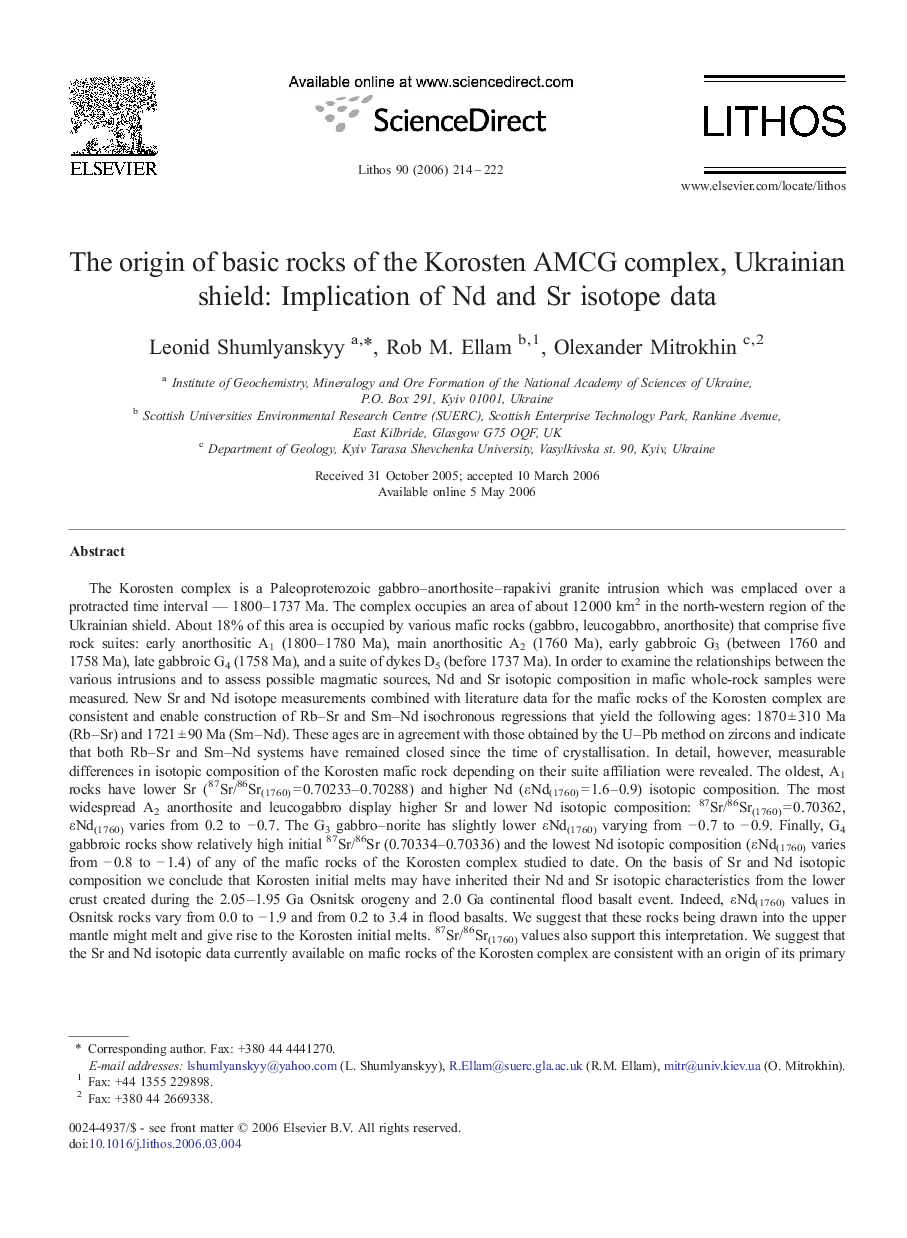| کد مقاله | کد نشریه | سال انتشار | مقاله انگلیسی | نسخه تمام متن |
|---|---|---|---|---|
| 4717979 | 1638777 | 2006 | 9 صفحه PDF | دانلود رایگان |

The Korosten complex is a Paleoproterozoic gabbro–anorthosite–rapakivi granite intrusion which was emplaced over a protracted time interval — 1800–1737 Ma. The complex occupies an area of about 12 000 km2 in the north-western region of the Ukrainian shield. About 18% of this area is occupied by various mafic rocks (gabbro, leucogabbro, anorthosite) that comprise five rock suites: early anorthositic A1 (1800–1780 Ma), main anorthositic A2 (1760 Ma), early gabbroic G3 (between 1760 and 1758 Ma), late gabbroic G4 (1758 Ma), and a suite of dykes D5 (before 1737 Ma). In order to examine the relationships between the various intrusions and to assess possible magmatic sources, Nd and Sr isotopic composition in mafic whole-rock samples were measured. New Sr and Nd isotope measurements combined with literature data for the mafic rocks of the Korosten complex are consistent and enable construction of Rb–Sr and Sm–Nd isochronous regressions that yield the following ages: 1870 ± 310 Ma (Rb–Sr) and 1721 ± 90 Ma (Sm–Nd). These ages are in agreement with those obtained by the U–Pb method on zircons and indicate that both Rb–Sr and Sm–Nd systems have remained closed since the time of crystallisation. In detail, however, measurable differences in isotopic composition of the Korosten mafic rock depending on their suite affiliation were revealed. The oldest, A1 rocks have lower Sr (87Sr/86Sr(1760) = 0.70233–0.70288) and higher Nd (εNd(1760) = 1.6–0.9) isotopic composition. The most widespread A2 anorthosite and leucogabbro display higher Sr and lower Nd isotopic composition: 87Sr/86Sr(1760) = 0.70362, εNd(1760) varies from 0.2 to − 0.7. The G3 gabbro–norite has slightly lower εNd(1760) varying from − 0.7 to − 0.9. Finally, G4 gabbroic rocks show relatively high initial 87Sr/86Sr (0.70334–0.70336) and the lowest Nd isotopic composition (εNd(1760) varies from − 0.8 to − 1.4) of any of the mafic rocks of the Korosten complex studied to date. On the basis of Sr and Nd isotopic composition we conclude that Korosten initial melts may have inherited their Nd and Sr isotopic characteristics from the lower crust created during the 2.05–1.95 Ga Osnitsk orogeny and 2.0 Ga continental flood basalt event. Indeed, εNd(1760) values in Osnitsk rocks vary from 0.0 to − 1.9 and from 0.2 to 3.4 in flood basalts. We suggest that these rocks being drawn into the upper mantle might melt and give rise to the Korosten initial melts. 87Sr/86Sr(1760) values also support this interpretation. We suggest that the Sr and Nd isotopic data currently available on mafic rocks of the Korosten complex are consistent with an origin of its primary melts by partial melting of lower crustal material due to downthrusting of the lower crust into upper mantle forced by Paleoproterozoic amalgamation of Sarmatia and Fennoscandia.
Journal: Lithos - Volume 90, Issues 3–4, September 2006, Pages 214–222